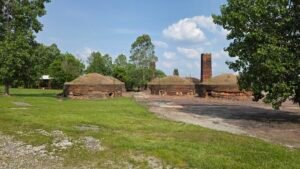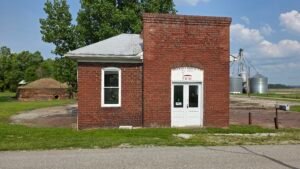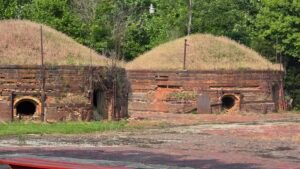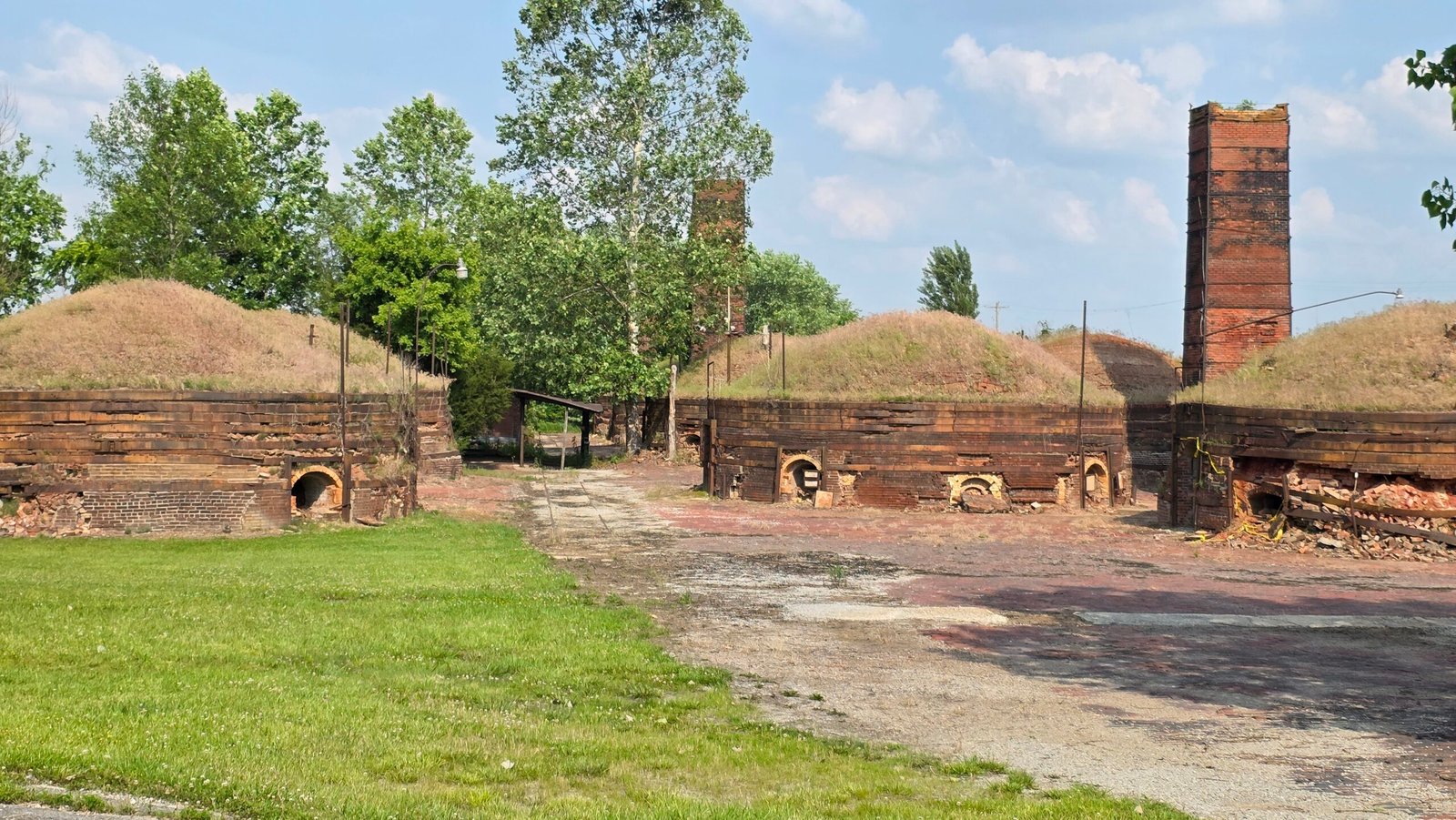While Linda and I were exploring the Medora Covered Bridge—not just the longest historic covered bridge in the U.S., but arguably the most photogenic plank of wood in Indiana—we spoke with a very friendly local. He shared some fond memories of growing up near the bridge, complete with the details only someone who’s lived in town forever can offer. Midway through our chat, he leaned in and asked, “Did you see the old brick plant?”
I blinked. Brick plant? Nope—we were all about bridges that day.
He went on to describe it like it was Medora’s best-kept secret (which, to be fair, it kind of is). I tucked away every detail like a squirrel hoarding blog ideas for winter. Sure, we were there for the bridge—but this blog? This one’s about the Medora Brick Plant, a place with a gritty, fascinating past that’s way too interesting to stay hidden behind the bridge’s shadow.
The Medora Brick Plant – Indiana’s Beehive Beauty with a Gritty Past
Tucked into the quiet hills of Jackson County, Indiana, the Medora Brick Plant might look like something out of a steampunk movie—towering beehive kilns, rusted rails, and the bones of a bygone industry. But this place isn’t just a photogenic ruin; it’s a gritty symbol of Indiana’s industrial heart, and the locals are determined not to let it crumble into dust.

Bricks, Beehives, and Big Dreams

In 1904, someone had a bright idea: “Let’s build bricks out of the dirt under our feet.” Thus, the Medora Shale Brick Company was born. By 1906, they were churning out bricks by thousands—by hand. Yes, hand. (Can you imagine explaining that job to your chiropractor?)
The location was perfect, sitting on a goldmine of shale and right next to the Baltimore & Ohio Southwestern Railroad, which happily hauled bricks off to all corners of the Midwest.
During it sprime, the plant had about 50 employees and could produce over 54,000 bricks a day. That’s a lot of bricks! Enough to build your dream home… your neighbor’s… the local high school… and still have bricks left over for a town square.
A Tough Job with a Tight-Knit Crew
Working at the plant wasn’t exactly a walk in the park. It was hot, it was dusty, and the massive kilns burned coal like there was no tomorrow. Workers hauled, shaped, and fired bricks in the kind of heat that would make a sauna jealous—like working inside a coal-fired dragon’s belly.
Still, it was more than just a job—it created a sense of community. Brickmakers swapped stories, shared meals, and probably complained about the weather together. Over time, the plant became part of the town’s identity. Kids grew up hearing stories of dads and grandpas who had “survived the kilns.”

Medora’s Backbone
This wasn’t just a factory; it was the heartbeat of Medora. The economy thrived thanks to the steady work and the stream of business the plant attracted. Even after the last brick was fired in 1992, the echoes of its heyday still bounce around town. Local schools, sidewalks, and even parts of Purdue and Ball State owe their red-baked walls to Medora.
Just think—if you’ve walked past brick buildings in Indiana, you may have brushed shoulders with Medora’s handiwork.
Even though the fires went out, the story of the Medora Brick Plant was far from over.
From Ruin to Revival

In 2004, Indiana Landmarks put the plant on its “10 Most Endangered” list—not exactly an award you hang in the breakroom, but it got people’s attention. That same year, a group of determined locals formed Medora Brick Plant and Historical Sites, Inc. Their mission? To breathe new life into the old site without losing its soul.
Restoration hasn’t been easy. Nature has a way of reclaiming abandoned spaces (and vines are surprisingly strong). But volunteers have worked hard to stabilize kilns, clear debris, and raise awareness. The goal is to eventually create a historical park—a place where visitors can explore the site, learn about old-school brickmaking, and maybe leave a little less afraid of manual labor.
Visiting Today: Bring Your Curiosity (and Your Camera)
While the brick plant itself isn’t open for regular tours just yet, you can still visit Medora, walk the quiet paths near the kilns, and feel the stories baked into every brick. Just a stone’s throw away—or maybe a brick’s toss?—is the famous Medora Covered Bridge, the longest historic covered bridge in the country. You’ll also find a town full of friendly folks who know their history and aren’t shy about sharing it.
For a small place, Medora packs a lot of personality—and a whole lot of fired clay.
Why It Matters
Preserving the Medora Brick Plant isn’t just about old bricks—it’s about honoring the sweat and stories behind them and showing that even a quiet Indiana town can help build a legacy—literally.
If you’re the type who gets excited about rusty ruins, blue-collar history, or just a good comeback story, the Medora Brick Plant belongs on your travel list.

Travel Tip:
Want to support the restoration? Visit www.medorabrickplant.org to donate or learn more. Your dollars help keep Indiana’s history from turning completely to dust—and maybe get a few raccoons evicted in the process. get a few raccoons evicted in the process.
Check out the map below for directions to the Medora Brick Plant.
Free Day Trip Checklist
Click the button below to download a free copy of my Day-Trip Checklist

Mike & Linda: Exploring the world’s forgotten, hidden, historic wonders. Join their journey as they share tales, tips, and timeless travel moments.

